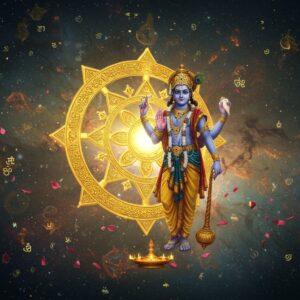
In the rich tapestry of Hindu mythology, the story of Vishvamitra and Menaka stands out as a captivating narrative. It explores themes of love, temptation, duty, and the pursuit of spiritual enlightenment. This myth offers a glimpse into the cultural values and beliefs of ancient India, providing insights into the lives, aspirations, and struggles of those times. Understanding this story helps us appreciate its enduring significance in both historical and modern contexts.
Vishvamitra’s Transformation: From King to Sage
Vishvamitra’s journey begins as a powerful king, driven by worldly ambitions and a thirst for recognition. His story is a remarkable transformation from royalty to revered sage. He renounces his kingly life to pursue spiritual greatness, aiming to achieve the highest spiritual rank – Brahmarishi. This path is fraught with challenges, testing his resolve and demanding immense perseverance.
Throughout his arduous journey, Vishvamitra grapples with human flaws like anger and ego. These internal struggles become crucial stepping stones in his spiritual development. They force him to confront his weaknesses and learn valuable lessons about humility and self-control. His story serves as an inspiration for those seeking spiritual fulfillment, demonstrating that transformation is possible even amidst internal conflict.
Menaka: More Than Just a Celestial Nymph
Menaka, a celestial nymph (Apsara) from Indra’s court, plays a pivotal role in this timeless tale. Her character embodies grace, intelligence, and an innate talent for captivating those around her. She is not merely a figure of beauty, but a complex individual with her own desires and motivations. Menaka yearns for love and family, adding depth to her character beyond her divine duties. Her presence in the story introduces layers of intrigue and emotional resonance.
Indra, threatened by Vishvamitra’s growing spiritual power, dispatches Menaka to disrupt the sage’s meditation. Her mission is to use her enchanting charm to lead Vishvamitra astray. However, Menaka’s involvement becomes more than just a divine errand. Her own emotions and aspirations intertwine with the events, making her a multifaceted character in the narrative.
The Encounter and its Repercussions
Menaka’s arrival in Vishvamitra’s life marks a turning point in his spiritual journey. Her captivating beauty breaks his meditative trance, igniting a whirlwind of emotions. Their union results in the birth of Shakuntala, a significant figure in Indian mythology, further complicating the narrative. This encounter throws Vishvamitra into inner turmoil, challenging his commitment to spiritual purity.
The realization of Indra’s scheme brings a mix of anger and understanding. Vishvamitra recognizes Menaka’s own genuine affection for him. While Menaka’s departure, ordered by Indra, leaves a void, it also strengthens Vishvamitra’s resolve. He resumes his penance with renewed determination, his experience with Menaka becoming a significant chapter in his spiritual evolution.
Cultural and Symbolic Significance
The story of Vishvamitra and Menaka transcends its narrative form, offering profound symbolic meaning. It depicts the eternal conflict between earthly desires and spiritual aspirations. Vishvamitra’s struggle embodies the universal human challenge of maintaining self-control and perseverance in the face of temptation. Menaka’s role underscores the potent influence of human emotions and the complexities of relationships.
Even in contemporary society, the themes explored in this myth resonate deeply. The story serves as a moral compass, guiding individuals to seek balance between material ambitions and spiritual growth. It encourages reflection on the nature of desire, duty, and the pursuit of a meaningful life. This ancient tale provides a framework for understanding the human condition and the ongoing quest for self-discovery.
A Timeless Legacy in Art and Literature
The legend of Vishvamitra and Menaka has profoundly influenced Indian literature and arts. Kalidasa’s renowned play “Abhijnanashakuntalam” draws inspiration from this story, showcasing its enduring appeal. Numerous artists have reinterpreted the tale through paintings, sculptures, and theatrical performances, ensuring its continued presence in cultural expression.
The myth’s adaptability to various art forms demonstrates its enduring legacy. It acts as a bridge between ancient traditions and contemporary interpretations. The story continues to inspire new creative adaptations, keeping its essence alive for modern audiences.
Explore the Significance of Divine Names in Hinduism
Connect with the Story’s Essence through Poojn.in
Deepen your connection to the spiritual themes of Vishvamitra and Menaka’s story with authentic puja items from Poojn.in. We offer a wide selection of Brahmin-certified products perfect for creating a sacred atmosphere and supporting your spiritual practices:
- Pure copper kalash and accessories: Enhance your meditation rituals just like Vishvamitra.
- Premium kusha grass mats: Create an ideal setting for meditation and spiritual practices.
- Traditional dhoop and agarbatti sets: Infuse your space with sacred fragrances.
- Pure brass diyas and deepams: Illuminate your rituals with traditional lighting.
- Authentic rudraksha malas: Enhance your focus and deepen your meditation practice.
We deliver these sacred items across India, ensuring proper ritual purification before shipping. For personalized guidance on product selection and usage, our customer service team is available at 91 3369029784.
Visit poojn.in today to discover our complete collection and enhance your spiritual journey.
Each product is meticulously packaged to maintain its sacred nature and comes with an authenticity certificate, guaranteeing the highest quality and spiritual integrity.
Discover 100% Pure Hanuman Sindoor
FAQs on Vishvamitra and Menaka
What is the central theme of the Vishvamitra and Menaka story? The story revolves around the conflict between worldly temptations and spiritual dedication. It highlights the challenges faced by those seeking enlightenment and the importance of staying focused on one’s path.
Why did Indra send Menaka to disrupt Vishvamitra’s penance? Indra, fearing Vishvamitra’s growing spiritual power, saw him as a potential threat. He sent Menaka to break Vishvamitra’s concentration and hinder his spiritual progress.
What were the consequences of Menaka’s interaction with Vishvamitra? Menaka’s presence disrupted Vishvamitra’s penance, temporarily diverting him from his spiritual goals. However, it also led to the birth of Shakuntala and ultimately strengthened Vishvamitra’s resolve.
What is the significance of Shakuntala in this narrative? Shakuntala, the daughter of Vishvamitra and Menaka, becomes a pivotal character in her own right. Her story continues in the Mahabharata, further enriching the tapestry of Hindu mythology.
How did Vishvamitra respond after discovering Indra’s deception? While initially angered by the deception, Vishvamitra eventually forgave Menaka. He recognized her genuine feelings and understood her helplessness in the situation. This act of forgiveness marks a significant point in his spiritual growth.
Conclusion
The story of Vishvamitra and Menaka remains a timeless narrative, imparting wisdom and insights into the human condition. It beautifully illustrates the challenges of balancing worldly desires and spiritual aspirations. Menaka’s character adds layers of complexity, reminding us of the power of emotions and the enduring quest for love and connection. Vishvamitra’s journey emphasizes the importance of perseverance, self-control, and the transformative power of forgiveness. This ancient myth continues to inspire and resonate with those seeking a deeper understanding of themselves and the world around them.


